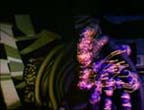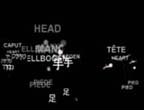June 09, 2006
Simulacrum Populi (a.k.a. "MultiCultureMolecular Humans")

PAYSAGES PARALLELES
Simulacrum Populi (a.k.a. "MultiCultureMolecular Humans") by Jaanis Garancs at Festival Bandits Mages, Bourges: The term 'multiculturemolecular virus' is used as a (slightly ironic) metaphor for human physical and mental interaction – through genes, memes and code. This interaction could be also described as sharing, exchange, competition and conflict among various nations, ideologies and cultures.
Forces of human natural life cycles, human passion, the will and spirit move the 'multiculturemolecules'. It can be a striving for balance, dominance or survival from individual – to state or whole ethnos scale. Either living in symbiosis with others, adjusting or changing themselves or taking somebody else's place – in various parallel power levels.
Diplomats, tourists, spies, PR agents, guest workers, mixed family children, soldiers, refugees, etc., spread 'viruses' or 'anti-viruses' that bring both 'illnesses' as well as 'cures' to them.
What is more important in the today's globalisation context and mediated reality, culture clashes, economical competition and personal privacy challenges? Is it the mass of combined number of inhabitants, nations gross domestic product, income-per-capita, age-structure? Or – it is the organisation level, cultural vitality or 'spiritual strength' of an individual? This artwork does not give the answer, but tries to show the possible bridges (interferences) between mental and physical social ambiences. Lightly humorous comments on some 'popular phobias', 'nostalgias' and 'conspiracy theories' are combined with a somewhat dark future vision on mixed digital and organic realities.
Realisation: (premiere at the Ars Electronica Festival 2002) SEE VIDEO (RealMedia) | snapshots (JPG)

Interactive installation, 3D stereo projection with 3D (8-channel, XYZ) sound. Visitors can observe dynamic scenes made of letters, signs and symbols. These 'molecules' contain fragments of language (i.e. Latin-, Arabic-, Asian- etc. words and characters) and symbols of cultural identity: country flags, landscape, trademark and other imagery. On visitor activity the global map 'morphs' and zooms into landscapes, city streets and human figures that also are made of the signs. During user inactivity period the scene influxes back into a world map made up of pulsating characters, e.g. from languages typical to the according world part.

Users can change navigate scenes with several joysticks by changing the viewpoints and density of scenes. Approaching the human figures, their bodies appear to be made also from names of the body parts in various languages. By zooming into the figures and the body parts, the 'resolution' increases: e.g. 1) 'head', 2) 'hair+face', 3) 'lips'+'cheek’, 4) 'upper lip' + 'lower lip', etc.
The density and activity of avatars in specific area makes influence on the surrounding area and avatars (following the rules similar to the Game-of-Life). The avatar presence in various scene parts and mutual 'collisions' induce 'firework' and 'fusion'-like effects on their 'molecules'. When one avatar leaves some area, some other avatar entering that space partially 'repaints' that environment with its own 'molecule traces' or 'catch' and get 'infected' by surrounding 'foreign molecules'. The stereoscopic projection and quadraphonic sound creates an audiovisual illusion of ghost-like presence in the room (projected images – 'walk in and out' of the screen). The remaining traces also create an impression of ever changing landscape or fluid city.
Posted by jo at June 9, 2006 10:11 AM
